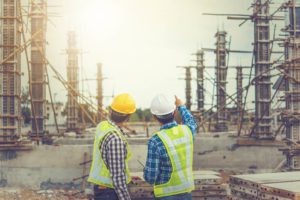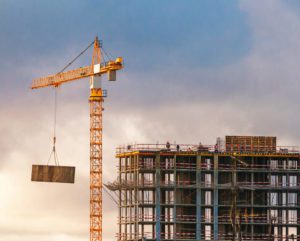Technology is constantly being enhanced and new technologies developed that improve the way the construction industry operates. However, one aspect that often goes overlooked is how new technology can be used to improve construction site safety.
Despite the best efforts of the construction industry, construction sites are simply hazardous environments. Countless workers, power tools, heavy equipment, machinery, vehicles and structures all pose a threat to construction site health & safety and pose a challenge.
Construction remains one of the deadliest occupations, fortunately, technological advancements have been made that can be used to better protect workers in construction. Here are a few examples of how new technology is improving health and safety and making construction sites safer.
The Problem With Managing Construction Safety Risks

When it comes to construction sites, one key safety goal is centred around identifying and managing potential risks. Construction sites present a unique set of challenges to health and safety, which is why new technologies are so helpful in overcoming these hurdles. Each construction site is unique and is in a state of constant flux.
In addition, in many cases, those responsible for construction site health and safety manage multiple sites and projects simultaneously across the country, which only adds to the difficulty in keeping them safe for workers.
How Technology Is Improving Health And Safety
There is a range of technologies that are being used to improve health and safety on construction sites. Such as:
Drones
The use of drones has increased significantly in recent years, from military applications to hobby uses. In the construction industry drones are seeing increasing use on construction sites for everything from site surveying to structure inspection. In addition, drones are also being used to make construction sites safer.
Drones are able to provide inspections of construction sites and identify any potential hazards without the risk of endangering any workers. They can also be used to monitor workers throughout the project to monitor the safe working conditions. In addition, drones are being used to document work progress each day to help everyone stay informed of the changing work conditions day by day.
VR/AR
Virtual Reality (VR) and Augmented Reality (AR) have been used extensively as training simulators for pilots or soldiers and it is possible that construction workers will be able to benefit from this technology soon. Training on everything from operating a crane or excavator to doing welding could be done with VR technology.
Safety training and equipment operation are two areas where VR technology could have a significant impact on construction site health and safety. In addition, VR can be used to prepare workers to working in confined spaces or at heights, which would reduce the risk of on-site accidents.
Self-Driving Vehicles
A lot of work has gone into making trucks safer for workers on construction sites, however, self-driving vehicles would go that step further and protect the one person that is still at risk during a crash, the driver. These vehicles would follow a lead vehicle that would use GPS to tell the self-driving vehicle when to turn, brake and what speed to travel.
In addition, heavy equipment manufacturers are working on machines capable of operating either autonomously or by remote control. This new technology allows operators to be completely removed from the machine to eliminate injuries from accidents such as rollovers.
Sensors
New sensors are being developed that can be deployed across construction sites and monitor things like noise levels, temperature, dust particulates and other variables. These sensors are a great tool for limiting exposure to workers on construction sites.

Site sensors like this are deployed throughout the construction site and are able to immediately alert workers when they are at risk from any hazards. In addition, data from these sensors are collected and stored for future use in analyzing risks.
Exoskeletons
Exoskeletons or power suits have existed in sci-fi for a long time, however, in the real-life exoskeletons are being developed for industrial use to allow workers to lift and carry much heavier objects or larger tools for extended periods of time, without the strain and damage done to their bodies.
Less advanced versions that are unpowered are designed to reduce fatigue and injury in workers by maintaining proper posture. These suits use counterweights or help to redistribute loads to stronger muscles to make lifting easier.
Wearable Technology
Things like high-visibility vests and hard hats are the tip of the iceberg when it comes to wearables that can improve health and safety on construction sites. More advanced safety vests are being designed that incorporates real-time location systems and GPS so that workers can always be tracked on construction sites. Or safety vests that include an airbag collar that would deploy in the event of a fall.
Advanced hard hats are being developed that include solar chargers that can be used to charge high-tech safety vests or built-in LEDs that operate as both a work light and a safety beacon. In addition, smart clothing can be used to monitor workers vital signs, such as temperature, respiration rate and heart rate.
The Benefits Of Construction Health & Safety Technology
In all of the examples above, new technologies are helping to improve response times to injuries, improve morale, limit the damage of accidents and reduce incident exposure. In addition, a safer job site is a more productive one which helps to get projects completed on time and one budget.
With fewer injuries, thanks to new technology improving health and safety, workers will be able to spend more time working. With the right technology in place, construction sites will be much safer and have a positive impact on employee satisfaction and retention.

